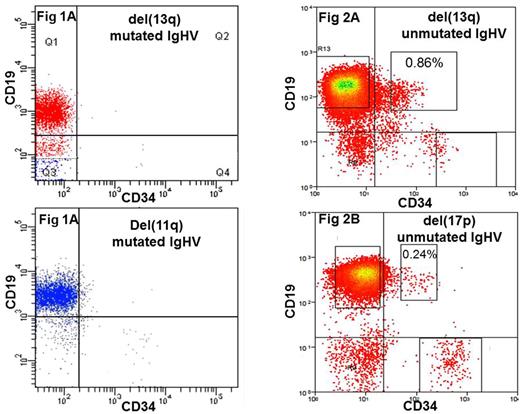Abstract
Background: It is now clear that CLL is a heterogeneous disease with varied prognoses. Cytogenetics and IgHV mutational status are 2 of the most important prognostic variables. Recent data from our group and others suggest that IgHV mutational status has a greater impact on prognosis than cytogenetics; accordingly, the small fraction (about 25%) of del(17p) and del(11q) CLL patients with mutated IgHV have relatively favorable prognoses, while those (about 30%) del(13q) patients with unmutated IgHV have relatively unfavorable prognoses. Although CLL with mutated IgHV should arise from a post-germinal center B cell, we studied whether IgHV unmutated CLL could arise as early in B cell differentiation as a CD34+CD19+ cell.
Methodology: We prospectively studied 20 patients with overt mutated IgHV CLL and 31 with overt unmutated IgHV CLL for the presence of CD34+CD19+ cells harboring the specific patient's CLL cytogenetic abnormality by fluorescence in situ hybridization (FISH). CD34+ cells were isolated from the patients' peripheral blood by magnetic bead and column (Miltenyi Biotec). The isolated cells were then analyzed by flow cytometry for CD34 and CD19 expression, and CD34+CD19+ cells (if present) were sorted onto slides and FISH performed using probes specific for the patient's known cytogenetic abnormality.
Results: Essentially no population of CD34+CD19+ cells could be detected circulating in patients with mutated IgHV (Figure 1, 2 representative patients). However, there was a small (0.32% of circulating cells, range 0.15-1.5%), but easily detectable, population of CD34+ cells in 29/31 patients with unmutated IgHV (Figure 2, 2 representative patients with sorting gates shown) regardless of the cytogenetic abnormality [9 patients with +12, 7 with del(13q), 6 with del(17p), 5 with del(11q), and 4 with other). These CD34+ cells were exclusively CD19+. The 2 unmutated patients without detectable CD34+CD19+ cells both harbored +12 abnormalities. When enough CD34+CD19+ cells were isolated for FISH analysis, the CLL-specific chromosomal abnormality was detected in 99+1% of the CD34+CD19+ cells, including in those patients with del(13q) and unmutated IgHV (Figure 2A).
Conclusion: We show that CD34+CD19+ cells harboring the CLL-specific cytogenetic abnormality can be found in the vast majorith of CLL patients with unmutated IgVH, regardless of cytogenetic abnormality. We could not detect these cells in CLL patients with mutated IgHV. These data suggest that the IgHV mutational status may provide a glimpse into at least 2 biologically distinct diseases, both of them currently called CLL. The primitive cell of origin in unmutated IgHV CLL may in part explain its poorer prognosis,and suggests that this form of CLL is indeed a leukemia, arising from the bone marrow.
No relevant conflicts of interest to declare.
Author notes
Asterisk with author names denotes non-ASH members.


This feature is available to Subscribers Only
Sign In or Create an Account Close Modal